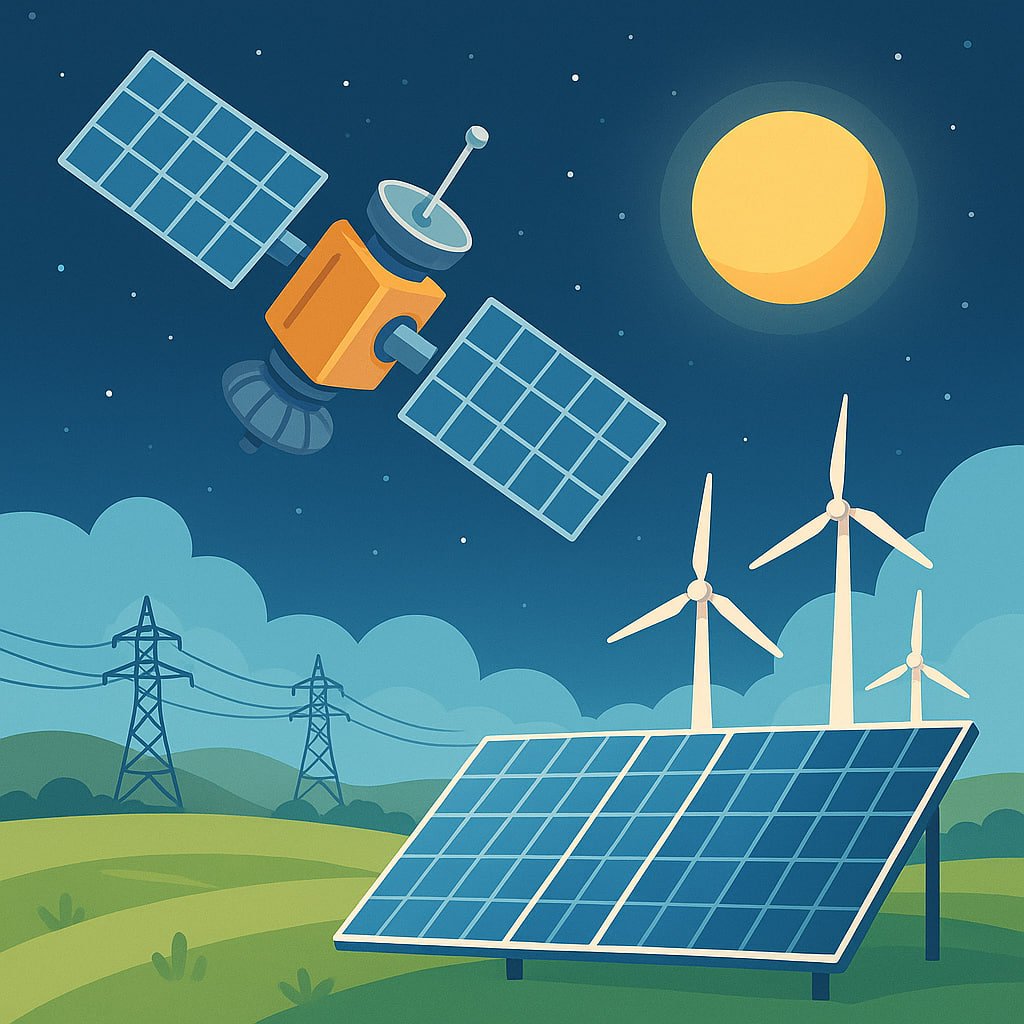How Space Supports Energy Transition – From Satellites to Solar Power

The global shift toward clean and renewable energy is one of the defining challenges of the 21st century. While most discussions focus on technologies like solar panels, wind turbines, and electric vehicles, an often-overlooked player is quietly transforming how the world approaches sustainability: space technology. From satellite-based climate monitoring to solar power generation in orbit, space is becoming an essential ally in the global energy transition.
What Is the Energy Transition and Why Does Space Matter?
The energy transition refers to the global movement from fossil fuels toward cleaner, renewable energy sources. It involves not only switching energy types but also redesigning entire systems—from how electricity is produced to how it is stored, distributed, and consumed. Achieving this shift requires accurate data, efficient resource management, and innovative technologies that minimize environmental impact.
This is where space technology comes in. Satellites, space-based sensors, and data analytics are now critical tools in the world’s sustainability toolbox. They provide real-time insights into the Earth’s resources, helping governments, scientists, and companies make informed decisions about renewable energy development and environmental protection. In 2025, over 7,000 active satellites orbit Earth, many of which are dedicated to monitoring weather patterns, carbon emissions, and energy infrastructure performance.
Practical Tip:
Organizations investing in renewable energy projects can use satellite data to identify ideal locations for solar and wind installations, maximizing efficiency and reducing development costs.
Satellites and Data: The Eyes of the Energy Transition
Space-based observation systems are revolutionizing how data is collected and applied in the renewable energy sector. Modern satellites can measure everything from solar radiation and wind speed to soil moisture and temperature variations—all essential factors in planning sustainable energy systems.
1. Mapping Renewable Energy Potential
Before building large-scale solar farms or wind parks, developers must assess where energy potential is highest. Satellites like the European Space Agency’s Sentinel series and NASA’s Landsat program provide precise, long-term datasets that identify regions with optimal sunlight, wind flow, and topographical conditions. These insights reduce the risk of investment and speed up project development.
2. Monitoring Infrastructure and Efficiency
Once energy systems are operational, satellites continue to play a role. High-resolution imagery can detect equipment failures, heat leaks in power plants, or changes in vegetation around wind farms. For instance, infrared imaging helps track the performance of solar panels, ensuring they operate at peak capacity. This proactive monitoring saves time, reduces maintenance costs, and minimizes downtime.
3. Tracking Environmental Impact
One of the greatest challenges in the energy transition is ensuring that renewable energy projects are genuinely sustainable. Satellite data helps verify environmental compliance, monitor biodiversity, and detect land-use changes caused by new installations. This transparency builds public trust and supports responsible growth of the renewable sector.
Practical Tip:
Energy planners can use open-access satellite platforms like NASA EarthData or the Copernicus Open Access Hub to access free datasets for renewable project planning and environmental assessments.
Space-Based Solar Power: Energy Beyond Earth
Imagine capturing solar energy 24 hours a day without the limits of weather or nightfall. This concept, known as space-based solar power (SBSP), is moving from science fiction to scientific reality. In orbit, solar panels can collect sunlight continuously and beam it back to Earth using microwaves or laser transmission systems.
In 2025, several international programs are testing SBSP technology. The European Space Agency’s “SOLARIS” initiative and Japan’s JAXA research missions are developing prototypes to demonstrate the viability of wireless energy transfer from space. If successful, SBSP could provide clean, uninterrupted power to remote regions or supplement existing energy grids during demand peaks.
Benefits of Space-Based Solar Power:
- Continuous energy generation: No interruptions due to weather or time of day.
- High efficiency: Solar radiation in space is around 10 times stronger than on Earth.
- Global access: Potential to supply energy to regions with limited renewable infrastructure.
Challenges to Overcome:
Despite its promise, SBSP faces engineering, safety, and cost hurdles. Launching massive solar arrays into orbit requires lightweight materials and reusable rockets to keep expenses manageable. Wireless energy transfer systems must also ensure safety for aviation and wildlife. However, with rapid advances in reusable launch technology and materials science, these obstacles are becoming more surmountable each year.
Practical Tip:
Investors and policymakers can track SBSP developments to anticipate future opportunities in clean energy markets, especially as space commercialization accelerates.
Space Technology and Grid Management
Managing renewable energy isn’t just about generating power—it’s also about ensuring stability and reliability across the grid. Space technologies play a crucial role in optimizing these systems.
Satellites equipped with communication relays and GPS systems help coordinate energy distribution, particularly in regions where terrestrial infrastructure is underdeveloped. In developing countries or disaster-prone areas, satellite-based connectivity allows remote energy networks—such as solar microgrids—to stay online even when local systems fail.
In addition, weather forecasting satellites help predict changes in solar radiation and wind patterns, allowing grid operators to plan for fluctuations in renewable output. With better forecasting, energy companies can balance supply and demand more effectively, reducing waste and preventing outages.
Practical Tip:
Utility companies can integrate space-based weather forecasting data into their operational models to enhance energy reliability and avoid costly disruptions.
Earth Observation and Climate Monitoring
The energy transition is deeply tied to climate goals. Understanding how renewable projects affect and respond to the environment requires consistent monitoring—and this is another area where space shines. Earth observation satellites track carbon dioxide levels, deforestation, glacier melting, and ocean temperatures, providing crucial insights into how energy systems interact with natural ecosystems.
For example, the European Space Agency’s Copernicus Climate Change Service uses satellite data to measure global greenhouse gas concentrations and assess progress toward the Paris Agreement targets. These insights support policymakers in creating evidence-based energy strategies that balance sustainability with economic growth.
Practical Tip:
Researchers and environmental consultants can leverage Earth observation data to evaluate carbon offset projects and verify emission reduction claims more accurately.
How Space Startups Are Driving Innovation
The private space sector is increasingly active in supporting the energy transition. Startups are developing small satellites designed specifically for renewable monitoring and resource mapping. Companies like Planet Labs and Spire Global offer high-frequency Earth imaging services that help track agricultural productivity, water resources, and solar performance with unprecedented precision.
Meanwhile, commercial launch providers such as SpaceX and Rocket Lab are lowering the cost of deploying satellites, making space data accessible even for smaller energy firms. This democratization of space resources is accelerating the spread of green technologies worldwide.
Practical Tip:
Energy entrepreneurs can collaborate with space startups to access customized satellite data that enhances project design and monitoring efficiency.
The Road Ahead: Collaboration Between Space and Energy Sectors
The intersection of space and energy is one of the most promising frontiers for sustainability. As technologies mature, collaboration between aerospace engineers, energy scientists, and environmental policymakers will be essential. Shared innovation can accelerate the deployment of space-enabled solutions—from advanced forecasting to carbon-neutral energy systems.
Moreover, international cooperation is key. Programs like the United Nations’ “Space4Climate Action” and the European Union’s “Green Deal Space Data” are already fostering cross-sector partnerships to integrate space insights into global energy policy.
Practical Tip:
Educational institutions and research organizations can promote interdisciplinary programs that combine space sciences and energy engineering, preparing the next generation of experts to lead this evolving field.
Conclusion: A Shared Future Between Earth and Space
The energy transition is not confined to the Earth’s surface—it now extends into orbit. Space technology offers the tools, data, and innovation necessary to accelerate the shift toward sustainable energy systems. From monitoring environmental changes to powering the planet with orbital solar panels, the role of space in the global clean energy movement is undeniable.
As 2025 unfolds, collaboration between the space and energy sectors will only deepen. The future of sustainable power may very well depend on what happens beyond our atmosphere. The question now is: how quickly can humanity harness the potential of space to build a cleaner, brighter, and more resilient world?
Call to Action: Explore how space technology is reshaping sustainability initiatives and consider how your organization can use satellite data or innovation partnerships to support the global energy transition.




